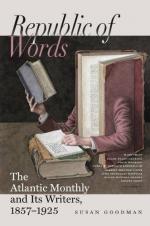presages of Art we may diverge and follow his development
as a poet by his engravings, without ever making reference
to him as a colorist. But beside being a poet,
he was a great color-composer. If, leaving poetry
as recited, we take the ballad, or poetry made fully
melodic, we have the single voice, passing through
measured inflections and with measured pauses.
Correspondingly, the next in the series of Turner drawings,
the “Aysgarth Force,” shows no attempt
to give the real color of Nature, but a single color
governing the whole drawing, a golden brown passing
in shadow into its exact negative. There is an
absolute tint, full, and inflected through every shade
of its tones to the bottom of the scale. The
strict analogy is broken in this case by a dash of
delicate gray-blue in the sky and gray-red in the
figures, the slightest possible accompaniment to his
golden-brown melody; but these were not needed, and
we find earlier drawings which adhere to the strict
monochrome. In the drawing next in date, the
“Hastings from the Sea,” we have the further
step from monochrome to polychrome; we have the distinct
trio, the golden yellow in the sky, the blue in the
sea, and the red in the figures in the boats,—as
in a vocal trio we have the only three possible musical
sounds of the human voice, the soprano, the basso,
and the falsetto of the child’s voice. All
these colors are distinctly asserted and perfectly
harmonized in a most exquisite play of tints, but
it is still no more like Nature than the trio in “I
Puritani” is like conversation. Turner
never dreamed of painting
like Nature, and no
sane man ever saw or can see, in this world, Nature
in the colors in which he has painted her, any more
than he will find men conducting business in operatic
notes.
One step farther, and we leave the analogy. In
the “Swiss Valley,” one of his last works,
we are from the first conscious that his harmonies
have run away with his theme. In Ole Bull’s
“Niagara” we have almost as much of matter-of-fact
Nature as in Turner’s “Swiss Valley.”
The eye untrained by study of Turner’s works
finds nothing but a blaze of color with no intelligible
object, just as we have, in opera, music of which
the words are inaudible;—both are there
for practised ear and eye, but in neither case as
of primary importance. Turner has even gone farther,
and given us pictures of pure color, as in the illustration
of Goethe’s theory of colors,—a fantasie
of the palette. And why shall Turner not orchestrate
color as well as Verdi sound? why not give us his
synchromies as well as Beethoven his symphonies?
You prefer common sense,—Harding and Fripp,
Stanfield and Creswick? Well, suppose you like
better to hear some familiar voice talking of past
times than to hear “Robert le Diable”
ever so well sung, or Hawthorne’s prose better
than Browning’s verse,—it proves nothing,
save that you do not care for music and poetry so
well as some others do.




